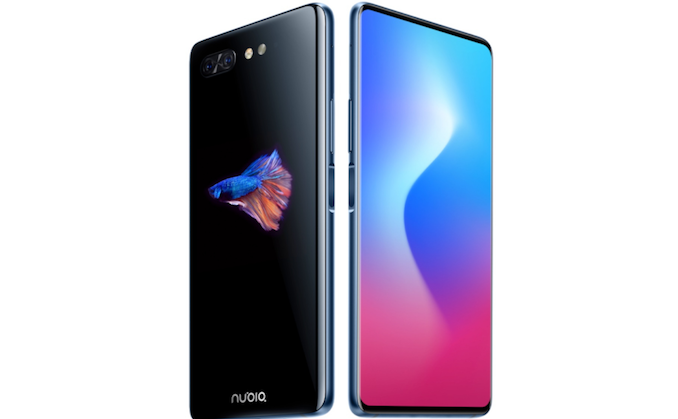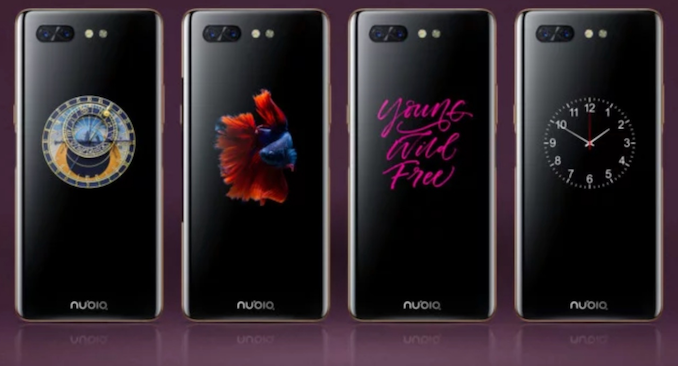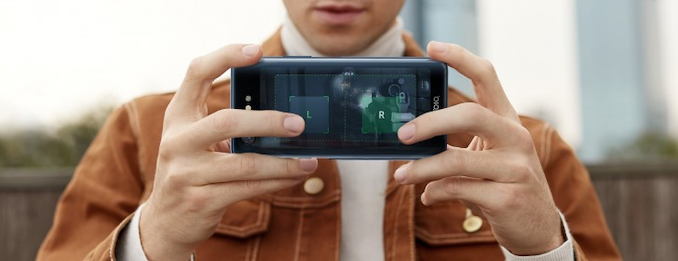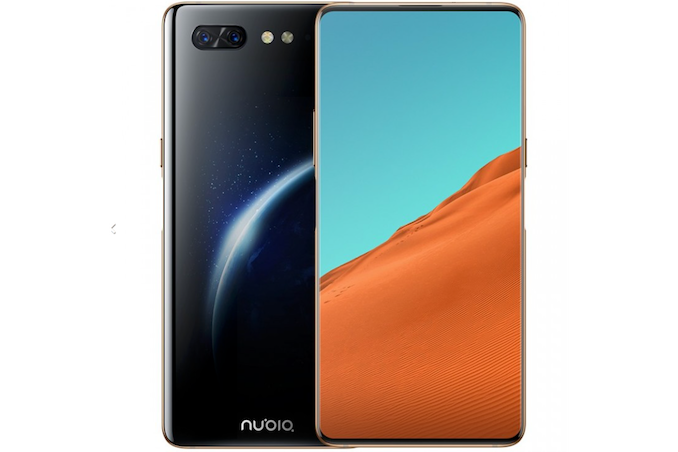Nubia X: a Dual-Display Smartphone with No Selfie Camera
by Anton Shilov on October 31, 2018 2:30 PM EST- Posted in
- Smartphones
- ZTE
- Nubia
- Snapdragon 845
- Nubia X

Nubia, a ZTE brand, this week introduced its new range-topping smartphone outfitted with front and rear displays and Qualcomm’s high-end SoC. The new Nubia X features a rare 93.6% screen-to-body ratio on the primary LCD, maximizing its screen real estate while also offering a serious performance. The phone will certainly catch some eyes, but what remains to be seen is how useful the second display is and how will it affect battery life of the device.
Impressive on the Outside
The two screens are naturally the key selling point of the Nubia X. The primary display is a 6.26-inch IPS LCD offering a 2280×1080 resolution, a 19:9 aspect ratio, and featuring no notch (as there is no camera). The secondary display is a 5.1-inch OLED that has the same aspect ratio, but a 1520×720 resolution. The screen on the rear of the smartphone blends with the device’s aluminum body and is designed primarily for ultimate personalization (e.g., you can load your own unique wallpaper on the back and get a handset no one else has). To make selfies as the Nubia X does not have a front-facing camera, but users will use the main camera and the rear screen to do so.
Speaking of the body, the Nubia X features a CNC-machined frame with Deep Gray, Black Gold, or Sea Light Blue finishes. The chassis has two side-mounted fingerprint readers, so the phone can be activated from either of its “sides”. It is noteworthy that despite packing two displays, the Nubia X is neither thicker or heavier than competitors. The phone has an 8.4-mm z-height and weighs 181 grams.
Powerful Inside
The smartphone is based on Qualcomm’s Snapdragon 845 SoC that integrates eight general-purpose Kryo 385 cores running at 1.80-2.65 GHz, the Adreno 630 GPU, a 64-bit LPDDR4X memory controller, Qualcomm’s X20 LTE modem, and so on. Right now, the S845 is Qualcomm’s flagship SoC for smartphones, so from processing and general features point of view, the Nubia X is on par with its competitors from other companies. The SoC is paired with 4 or 8 GB of LPDDR4X memory as well as 64 or 128 GB of storage. Interestingly, Nubia claims that it uses graphene layers too cool down the key electronic components of the Nubia X.
As for the battery, the handset is equipped with a 3,800 Li-Po battery, which is in line with battery capacity of top-of-the-range smartphones from other makers. Meanwhile, one has to keep in mind that the Nubia X has second screen and therefore consumes more than competing devices. Even though OLEDs do not consume a lot of power, they still do consume some, so it will be interesting to see how long will the Nubia X live on one charge.
When it comes to imaging capabilities of the Nubia X, they are limited to the back-facing dual camera setup. The primary camera comprises of a 24 MP sensor with an f/1.7 aperture, followed by a 16 MP sensor with a f/1.8 aperture, and a dual-LED dual-tone flash (one of the LEDs is a soft light one). As noted above, the camera is designed to be used both for regular and for selfie photos. The latter will clearly benefit from an advanced flash and high-performance sensors, so the Nubia X could become popular among those interested in selfies. Nubia claims that its camera software can detect scenes and environments to adjust settings, but does not elaborate.
Next up is connectivity. The smartphone supports modern 4G/LTE networks, 802.11ac Wi-Fi, and Bluetooth 5.0 on the wireless side of things. As for physical interfaces, the Nubia X has a USB Type-C port for charging, but no 3.5-mm jack for headsets.
Nubia will ship the X with Google Android 8.1 OS and its own Nubia 6.0 UI.
| General Specifications of the Nubia X | |||
| Nubia X 6 GB + 128 GB |
Nubia X 8 GB + 256 GB |
||
| Display(s) | Size | 6.26 inches + 5.1 inches | |
| Resolution | 2280×1080 (19:9) + 1520×720 (19:9) | ||
| PPI | 403 PPI + 330 PPI | ||
| Cover | Gorilla Glass 3 | ||
| SoC | Snapdragon 845 4 × Kryo 385 Gold @ 2.65 GHz 4 × Kryo 385 Silver @ 1.80 GHz |
||
| GPU | Adreno 630 | ||
| RAM | 6 GB LPDDR4 | 8 GB LPDDR4 | |
| Storage | 64 GB | 128 GB | |
| Networks | GSM GPRS (2G), UMTS HSPA (3G), LTE (4G) CAT 18/13 (DL/UL) Peak Download Speed: 1.2 Gbps Peak Upload Speed: 150 Mbps |
||
| SIM Size | Nano SIM | ||
| SIM Options | Dual SIM | ||
| Local Connectivity | Wi-Fi 802.11ac, BT 5.0 USB Type-C |
||
| Front Camera | none | ||
| Rear Camera | 24 MP sensor with an f/1.7 aperture with PDAF 16 MP sensor with a f/1.8 aperture with PDAF Dual-LED dual-tone flash (one of the LEDs is a soft light one |
||
| Battery | 3,800 mAh | ||
| Dimensions | Height | 154.1 mm | 6.07 inches | |
| Width | 73.3 mm | 2.89 inches | ||
| Thickness | 8.4 mm | 0.33 inches | ||
| Weight | 181 grams | 6.8 ounces | ||
| Launch OS | Android | ||
Nubia will start sales of the X in early November in China with availability in other countries following a bit later. The version equipped with 6 GB of RAM and 64 GB of storage will cost around $470 in China, whereas the flavor accommodating 8 GB of RAM and 128 GB of storage will be priced at approximately $600.
Related Reading
- ZTE is Back: The Axon 9 Pro at IFA 2018
- ZTE Announces The Blade V8 Mini And Blade V8 Lite
- ZTE's CSX "Hawkeye" Concept Phone Detailed, Kickstarter Launched
- ZTE Announces Blade V8 Pro with Snapdragon 625, Hawkeye Phone
- MWC 2018: ZTE Blade v9 Live Blog (3pm UTC, 10am ET)
Source: Tom’s Guide, GSM Arena, AndroidCentral














45 Comments
View All Comments
Diji1 - Friday, November 2, 2018 - link
A phone that is thicker than AA (18650) batteries would look prehistoric.10basetom - Wednesday, October 31, 2018 - link
The back reminds me of the YotaPhone 2, except it's OLED instead of e-ink.wr3zzz - Wednesday, October 31, 2018 - link
I would like to see the battery test. It is the single biggest reason that other brands hadn't tried to commercially launch this kind of phone. Trust me that the engineers at every phone company worth its salt has had thought of it.Hereiam2005 - Wednesday, October 31, 2018 - link
The Graphene-as-heat-spreader part is completely BS.Graphene is only 20 times more heat conductive *at best* compared to copper, yet it is 1,000,000 times thinner than a 0.1 mm copper sheet. Since for it to work as heat *spreader* and spread heat horizontally, the thermal conductance is proportional to the thickness of the sheet, as such a basic 0.1mm copper sheet is about 50,000 times *more* effective as heat spreader than graphene.
Ugh. Stupid PR department.
shabby - Wednesday, October 31, 2018 - link
The pr department is just trying to make itself relevant, you'd do the same if your job was on the line basically.ddaniel91 - Thursday, November 1, 2018 - link
Genuinly curious, what prevents them from using multiple layers of graphene for transporting the heat? While I know that graphene itself is thin, they surely could use it stacked in some way and get better performance than copper?Hereiam2005 - Thursday, November 1, 2018 - link
Graphene only exhibit exotic properties if it is only several layers thin, from under 1 to 10 nm (dependent on the exact properties). Stacking too many layers will turn graphene into graphite.Or you could alternate between thin graphene and other insulating layers, which, other than the exorbitant price, kills the heat spreading performance because of the poor heat conductance of the insulating layers.
Depositing graphene on conductive materials will also kill its exotic properties because of the free electrons floating around.
Graphene sure is a wonderful material, but using it as a heat spreader is like using the Big Falcon Rocket as your dining fork.
In other words, don't do it.
mazz7 - Wednesday, October 31, 2018 - link
A Really interesting Phone, if it is Apple or Samsung it will be the biggest trend ever in a smartphone industry :)MamiyaOtaru - Thursday, November 1, 2018 - link
I don't actually consider a full body screen as a compelling selling point, but I really like their implementation of it. Being able to dedicate all your camera hardware to one camera seems nice, and I rather like the idea of making your own rear case design from any arbitrary image. If I'm going to be stuck with glass on the back of a phone might as well have a reason for itEletriarnation - Thursday, November 1, 2018 - link
Is the lower end model equipped with 4GB or 6GB of RAM? The article text initially says 4GB but then the chart and the pricing comment at the end refer to 6GB.